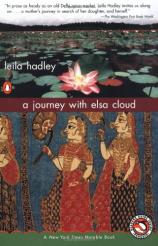Reading Group Guide
Discussion Questions
A Journey with Elsa Cloud

1. According to Veronica's Buddhist ideology, emotions are obstacles from which to detach and float above. Leila views her daughter's "detachment" as repression. Is it possible to truly detach from emotions and achieve a state of painless, beneficent bliss? Which interpretation does Veronica's behavior favor? How about the Tibetan monks? What common ground between the two theories does Leila find in Dharamsala?
2. The ideological conflicts between Veronica and Leila can also be viewed as the archetypal struggle between mothers and daughters-the daughter asserting distance in order to maintain a separate identity; the mother seeking to close the space between the two. How does this dynamic manifest itself throughout the book?
3. One of Leila's great gifts is her ability to connect events and objects of the present with a vast internal encyclopedia of interconnected ideas, memories, and associations. Veronica, by contrast, often prefers to experience the world without seeking to understand the "Felliniesque" chaos of sensations that fly by. Is Leila's power of association a defense mechanism against living in the present?
4. In Dharamsala, we find the Tibetans engaged in an exhaustive project of recording their culture to preserve it from oblivion. Is this in conflict with their quest to become indifferent to impermanence?
5. Leila learns during the journey that Veronica's teenage sexual exploration was not mere hedonistic pleasure-seeking, but a quest to find a man worthy of loving. In what sense is Veronica's spiritual odyssey a rejection of that previous search? In what sense is it a continuation?
6. Throughout the memoir, we learn of the separate techniques used by Hinduism, Buddhism, and Islam in order to gain cultural ascendancy in India. The Hindus and Buddhists assimilated pre-existing religions into their own, creating a mind-boggling panorama of deities under a single culture. Islam attempted to destroy all trace of the existing Hindu religion in order to impose its own. What are the advantages and disadvantages of each technique for the religion in question?
7. During India's New Year Festival of Holi, lower castes attack higher castes, wives assault husbands, children berate adults, normally servile hotel clerks splatter their guests with bright-colored dye, and sexual license reigns supreme. How does this abandonment of Hindu social restrictions paradoxically function in the service of those same strictures?
8. We learn that Tibetan Buddhists leave their dead outside for the animals and vultures to consume. How is this a reflection of their cultural and religious perspective, and why is this practice an anathema to Western values? In what sense is the practice of sealing the dead in caskets and burying them a reflection of the Judeo-Christian worldview?
9. The Tibetans also believe in the active participation of the patient in the process of overcoming sickness and of dying. What penalty does Western culture pay for denying the normality of illness and death and treating them as an aberration?
10. How reliable a witness is Leila to her own behavior and motivations? Is her perspective skewed when discussing her daughter? How would the book have appeared different to the reader if it had been presented in the form of a novel? What does the memoir genre enable the author to do that would have been more difficult in the medium of fiction?
A Journey with Elsa Cloud
- Publication Date: November 1, 1998
- Paperback: 624 pages
- Publisher: Penguin (Non-Classics)
- ISBN-10: 0140275371
- ISBN-13: 9780140275377






